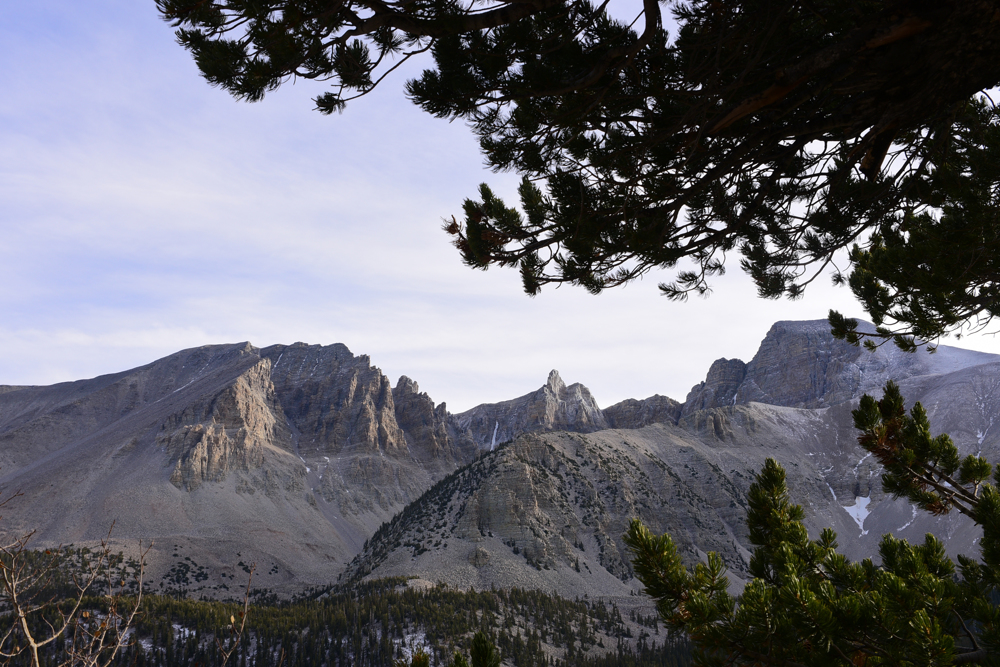Since 2016, ACE Youth & Community Conservation Programs division has partnered with Great Basin National Park in Baker, NV to engage local teens (ages 15 to 18) in developing tangible professional and interpersonal skills in conservation through the Great Basin Ranger Corps program. Established in 1986, the National Park is named after the Great Basin: a collection of 90 basins located in the mountains between the Sierra Nevada and the Wasatch Mountain ranges. Great Basin National Park has a lengthy cultural history, with occupation spanning over the last 12,000 years, along with an abundance and variety of natural features including desert, mountain, glacier, and cave ecosystems. The park is home to 238 bird species, 73 mammal species, 18 fish species, and over 800 plant species, among others.

Members Simon, Kara, and Kayli join Team Leadership Fellow Andrea for a crew photo at the Lehman Caves Visitor Center.
Most recently in 2019, four ACE members and one ACE Team Leadership Fellow worked within Great Basin National Park to assist in different areas, including cultural resources, visitor center services, and education & interpretation. Members often led multiple daily visitor tours through the Lehman Caves and assisted biologists in conducting biota surveys for proper humidity, air quality, and soil temperature in the caves. Along with roving the trails to provide park information to guests, the ACE Ranger Corps team took turns working in the Visitor Center, preparing inventory and answering visitor questions.

Team Leadership Fellow Andrea assists in setting up a telescope for an Astronomy Programs event in the Park.
Several times during the 320-hour term, Ranger Corps members had the opportunity to assist biologists in monitoring nearby fish populations through electrofishing. This process involves using two electrodes to pulse a direct current through the water, temporarily stunning nearby fish in order to take measurements such as species, length, and weight. Within minutes, the fish return to their original state with no lasting harm. Electrofishing also allows for the calculation of species density, abundance, and composition in the sample area.

Member Kara holds a captured fish while on an electrofishing outing.
An Interview with Great Basin Ranger Corps Team Leadership Fellow, Andrea Wagner: Along with tours and guest interaction, Team Leadership Fellow Andrea worked specifically to help organize member outings, update the Park’s events website, set up telescopes for night time Astronomy Programs, and conduct an annual snow survey to determine water content from a core sample. She even worked with biologists and ecologists to map out a closed section of the Lehman Caves!
Q: What is your favorite part about working with Ranger Corps?
A: The most enjoyable experience for me participating in the Ranger Corps program has been the opportunity to act as a leader and mentor to the younger members. Last season when I was part of an EPIC internship I was the only ACE member in the park, and so it has been a lot of fun having others around this summer season.
Q: What have you learned during your time in Ranger Corps?
A: Being a Crew Leader for Ranger Corps has taught me the value of having and being part of a team, the importance of intentional leadership, and the incredible fun it is to work for A.C.E!
Q: Do you have any plans for after the program?
A: I hope to continue working for the National Park Service in some capacity, either in interpretation or perhaps in natural resources.

Mapping out an off-route section of the Lehman Caves.

Member Simon uses a dip net, bucket, and safety gear while assisting in fish monitoring via electrofishing.
For more information about the history of Great Basin National Park, along with current events, please visit: https://www.nps.gov/grba/index.htm
